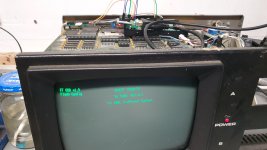bladamson
Veteran Member
Hey folks. I figured I ought to ask here before I start experimenting and blow something up. 
I'm looking to hook FlashFloppy's on-screen-display to various TTL video displays. The first one will be a Kaypro, but I'm also looking at doing a TRS-80 Model II and a Tandy 1000HX.
The flashfloppy-osd documentation says things about "vga" and "15khz" timings, but it doesn't have anything to say about other timings. I know MDA runs at an oddball non-15khz timing, but I don't know about the kaypro or Model 2. The 1000HX is TGA (CGA) and most certainly 15khz except for that one weird mode that nothing uses.
It looks to me like flashfloppy-osd uses the sync signals as inputs to sync its video line up to the display, and then uses its video line to pull the display up or down, right? So I hope that the exact timings aren't terribly critical, and it will sync to MDA type timings alright?
It also appears that all the hookup examples are 0.7vpp VGA or analog RGB video, rather than TTL video. I assume the bluepill is running at 3.3v, so is this going to work with 5v TTL video at all? Do I need to buffer it through a 5v device to raise the voltage? Is it going to damage the host computer's video output when trying to pull the signal low? Do I need to stick an open-collector buffer on the video output or something to isolate it?
Sorry for my dumbness. I just don't want to fry my hardware doing something stupid, heh.
Thanks, folks. I'd really appreciate any advice.
I'm looking to hook FlashFloppy's on-screen-display to various TTL video displays. The first one will be a Kaypro, but I'm also looking at doing a TRS-80 Model II and a Tandy 1000HX.
The flashfloppy-osd documentation says things about "vga" and "15khz" timings, but it doesn't have anything to say about other timings. I know MDA runs at an oddball non-15khz timing, but I don't know about the kaypro or Model 2. The 1000HX is TGA (CGA) and most certainly 15khz except for that one weird mode that nothing uses.
It looks to me like flashfloppy-osd uses the sync signals as inputs to sync its video line up to the display, and then uses its video line to pull the display up or down, right? So I hope that the exact timings aren't terribly critical, and it will sync to MDA type timings alright?
It also appears that all the hookup examples are 0.7vpp VGA or analog RGB video, rather than TTL video. I assume the bluepill is running at 3.3v, so is this going to work with 5v TTL video at all? Do I need to buffer it through a 5v device to raise the voltage? Is it going to damage the host computer's video output when trying to pull the signal low? Do I need to stick an open-collector buffer on the video output or something to isolate it?
Sorry for my dumbness. I just don't want to fry my hardware doing something stupid, heh.
Thanks, folks. I'd really appreciate any advice.




